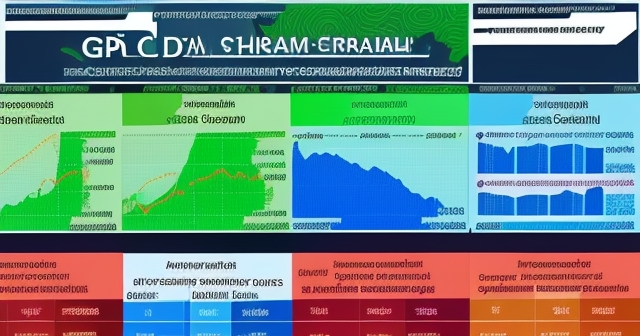Welcome to our exploration of national economic measurement. When we talk about the health and performance of a country’s economy, two acronyms often surface: Gross National Product (GNP) and Gross Domestic Product (GDP). Both are fundamental indicators, offering snapshots of economic activity, but they view this activity through slightly different lenses. Understanding these differences isn’t just an academic exercise; it provides crucial context for investors, policymakers, and anyone seeking to grasp the complex flows of the global economy.
- GNP focuses on the income generated by a nation’s residents regardless of where it is produced.
- GDP measures all economic activity occurring within a country’s borders.
- The distinction between GNP and GDP is essential for understanding a country’s global economic integration.
Think of it like this: GDP is concerned with what happens *inside* a country’s house, regardless of who is doing it. GNP, on the other hand, cares about who *owns* the stuff being produced, regardless of which house they are in. This distinction becomes increasingly important in our interconnected world, where businesses operate across borders and investments flow freely between nations. By the end of this discussion, you’ll have a clear grasp of what each metric represents, how they relate, why their difference matters, and how they are used to understand economic trends.

Let’s start with GNP. Gross National Product (GNP) is an estimate of the total value of all the final products and services produced by a country’s residents, regardless of where the production takes place. The key concept here is “residents.” GNP measures the economic output attributable to the citizens and firms of a specific nation, even if that output is generated in a foreign land.
Imagine a company headquartered in the United States, but operating a factory in Mexico. The value of the goods produced in that Mexican factory contributes to Mexico’s GDP, but it contributes to the U.S. GNP because the company is owned by U.S. residents. Similarly, the income earned by a U.S. citizen working temporarily in Germany is counted towards the U.S. GNP, not just Germany’s.
GNP seeks to paint a picture of the income earned and value created by a nation’s people and their enterprises, offering insight into the economic strength and reach of its residents in the global arena.
To avoid double-counting, GNP, like GDP, only includes the value of final goods and services. This means it doesn’t count intermediate goods – components used to produce other goods. For example, the value of tires sold to a car manufacturer isn’t counted separately; their value is embedded in the final price of the car.

How is GNP actually calculated? While various approaches exist, the most common way to conceptualize it is starting with GDP and making adjustments for international income flows. At its core, GNP is broadly calculated by taking Gross Domestic Product (GDP) and adding Net Factor Income from Abroad. This Net Factor Income is the critical link.
Let’s break down Net Factor Income from Abroad. It’s the difference between two things:
- Income earned by residents from overseas investments and activities: This includes profits earned by domestic companies’ foreign subsidiaries, income from foreign investments (like dividends, interest, and rent), and wages earned by residents working abroad.
- Income earned by foreign residents within the country: This includes profits earned by foreign companies’ domestic subsidiaries, income from domestic investments owned by foreigners, and wages earned by foreign residents working domestically.
So, the relationship can be simply expressed as:
| GNP Calculation | Formula |
|---|---|
| GNP | GNP = GDP + Income from overseas investments by residents – Income earned domestically by foreign residents |
This adjustment explicitly removes income flowing out of the country to foreign entities and adds income flowing into the country from its residents’ activities abroad. This is the fundamental difference that shifts the focus from geographical location (GDP) to nationality (GNP).

Now, let’s turn to the more commonly cited metric: Gross Domestic Product (GDP). GDP measures the total monetary value of all the final products and services produced *within* a country’s geographical boundaries over a specific period (usually a year or a quarter). The crucial phrase here is “within a country’s geographical boundaries.”
Unlike GNP, GDP doesn’t care about the nationality of the producer. If a foreign-owned company operates a factory inside the United States, the value of the goods produced contributes to U.S. GDP. If a German citizen works in New York, their wages contribute to U.S. GDP. GDP is fundamentally a measure of economic activity happening *on the home soil*, regardless of who is driving it.
GDP is typically calculated using the expenditure approach, summing up all spending on final goods and services in the economy. The major components of this calculation are:
- Personal Consumption Expenditures (C): Spending by households on goods and services. This is usually the largest component.
- Gross Private Domestic Investment (I): Spending by businesses on capital goods (like machinery and buildings), changes in inventories, and residential construction.
- Government Consumption Expenditures and Gross Investment (G): Spending by the government (federal, state, and local) on goods and services.
- Net Exports (NX): The value of a country’s total exports minus the value of its total imports.
| GDP Calculation Components | Formula |
|---|---|
| GDP | GDP = C + I + G + NX |
This formula highlights GDP’s focus on expenditures occurring *within* the economy’s borders.

We’ve defined GNP based on nationality and GDP based on location. Now, why is this distinction so important? The difference between a country’s GNP and its GDP, often referred to as the Net Factor Income from Abroad, reveals a great deal about a nation’s integration into the global economy and the structure of its income flows.
If a country’s GNP is significantly higher than its GDP, it suggests that the nation’s residents and firms are earning substantial income from their overseas investments and operations, and/or that foreign entities are earning relatively less within the domestic economy. This might be typical for a country with large multinational corporations that repatriate significant profits, or a nation that is a major global investor.
Conversely, if a country’s GDP is notably higher than its GNP, it indicates that foreign residents and firms are earning substantial income within the domestic economy, which is then flowing out of the country. This could be the case in a country that hosts a large number of foreign-owned subsidiaries that repatriate profits, or where foreigners hold significant domestic investments.
This gap isn’t just a statistical curiosity. A large difference can highlight dependency on foreign capital, the degree of foreign ownership of domestic assets, or the success of a nation’s companies in expanding globally. For policymakers, understanding this difference is crucial when considering how economic growth translates into income and prosperity for their own citizens.

For many years, the United States primarily used GNP as its main measure of economic activity. However, in 1991, the U.S. officially switched to using GDP as its primary economic indicator. Why the change?
The decision was largely driven by practical considerations aimed at making U.S. economic data more relevant and comparable. Firstly, GDP data was found to correlate more closely with other key domestic economic indicators that policymakers and businesses relied upon, such as employment levels and industrial production. These metrics are inherently tied to activity *within* the U.S. borders, making GDP a more aligned measure for understanding domestic labor and manufacturing conditions.
Secondly, and perhaps more significantly for a globalizing world, adopting GDP aligned the U.S. with the practice of most other developed nations and international organizations. This facilitated easier and more accurate cross-country economic comparisons, a necessity in an era of increasing international trade and investment. By using the same primary yardstick, it became simpler to compare the economic performance of the U.S. against that of Europe, Asia, and other regions.
While the U.S. Bureau of Economic Analysis (BEA) still calculates and publishes GNP data (referred to as Gross National Income, GNI, in international contexts, which is equivalent to GNP), GDP remains the headline figure for reporting U.S. economic growth and analyzing domestic conditions.
The difference between GDP and GNP can have dramatic real-world implications, particularly in smaller economies heavily integrated into the global economy. Ireland provides a compelling example.
Ireland has become a major hub for multinational corporations, particularly in the technology and pharmaceutical sectors, attracted by factors including favorable tax policies. These companies conduct significant economic activity within Ireland’s borders, contributing substantially to its GDP. However, a significant portion of the profits generated by these foreign-owned companies is often repatriated back to their parent companies overseas, meaning this income flows out of Ireland and doesn’t necessarily benefit Irish residents directly.
As a result, Ireland’s GDP figure is often significantly inflated by the activities of these large multinational enterprises (MNEs), sometimes creating a distorted picture of the underlying domestic economy. For instance, a surge in pharmaceutical exports by a foreign-owned company operating in Ireland boosts Ireland’s GDP, but the profits generated primarily benefit shareholders outside of Ireland.
Recognizing this distortion, Irish officials and economists often look at alternative measures to understand the true health of the domestic economy, such as Modified Domestic Demand (MDD). MDD strips out volatile components like multinational company effects, aircraft leasing, and R&D, aiming to provide a clearer view of spending and activity by Irish households and indigenous businesses. This highlights how, in certain contexts, GDP alone can be misleading, and other metrics (including GNP, or GNI as it’s internationally known, and modified measures like MDD) are essential for a more accurate analysis.
This situation underscores the value of looking beyond the headline GDP number, especially in countries with high levels of foreign direct investment and multinational corporate activity. It reinforces why understanding the GNP vs. GDP distinction is vital for gaining a true picture of economic prosperity that accrues to a nation’s residents.
Economic indicators like GDP are constantly being measured and reported, providing us with up-to-date insights into the economy’s performance. Let’s look at some recent data points, such as those reported for the U.S. economy in Q1 2025, to see how the components we discussed impact the headline figure.
In Q1 2025, the U.S. economy, as measured by real Gross Domestic Product (GDP), experienced a decrease. But what were the specific factors driving this change? Analyzing the components of GDP helps us understand the underlying dynamics.
Two major factors contributed negatively to this Q1 GDP figure:
Firstly, there was an increase in imports. Imports are subtracted in the GDP calculation (as part of Net Exports), because they represent spending by domestic entities on foreign-produced goods and services, thus not contributing to *domestic* production. A rise in imports, therefore, drags down the GDP number. In Q1 2025, this increase in imports was notably led by increases in consumer goods (specifically medicinal, dental, and pharmaceutical preparations, and vitamins) and capital goods (computers, peripherals, and parts). This suggests robust domestic demand for foreign products in these categories.
Secondly, there was a decrease in government spending. Specifically, federal government spending saw a reduction, largely attributable to decreased defense consumption expenditures. While state and local government spending increased slightly, the federal decrease had a larger negative impact on the overall government component of GDP.
However, these negative contributions were partially offset by increases in other areas:
Investment saw a notable increase. This rise was led by private inventory investment, particularly in wholesale trade (specifically drugs and sundries). An increase in inventories suggests businesses produced more goods than they sold in the quarter, adding to the stock of goods and services within the economy’s borders.
Consumer spending, the largest component of GDP, also increased. This growth in personal consumption expenditures was primarily reflected in increased spending on services, such as healthcare, housing and utilities. While spending on goods (both durable and nondurable) decreased, the strength in services spending helped boost the overall consumption figure.
Finally, exports increased, although this positive contribution was smaller than the negative impact from increased imports, resulting in a net negative contribution from net exports overall. The rise in exports included components like industrial supplies and materials, and capital goods (excluding autos).
This detailed breakdown shows how the different pieces of the economic puzzle, from consumer habits and government decisions to international trade flows and business investment, converge to determine the final GDP number. For anyone trying to understand the economy, looking beyond the single headline figure and into its components is essential.
National income accounts like GDP and GNP are not just historical records; they are vital tools for policymakers, especially central banks responsible for monetary policy. Central bankers, like those at the Bank of Canada, closely monitor these figures to gauge the overall health of the economy, understand inflationary pressures, and make decisions about interest rates.
A strong GDP growth figure can signal a robust economy, potentially operating near or at full capacity. In such an environment, demand might outpace supply, leading to inflationary pressures. Central banks might respond by considering raising interest rates to cool down the economy, curb borrowing, and temper inflation.
Conversely, weak or negative GDP growth could indicate a sluggish economy, potentially facing recessionary risks and rising unemployment. In this scenario, central banks might consider lowering interest rates to stimulate borrowing, investment, and consumer spending, thereby aiming to boost economic activity.
The Bank of Canada, for example, explicitly considers recent GDP data, including the breakdown of its components, when deliberating on its monetary policy stance. Analysis of Canada’s Q1 2025 GDP performance would have fed into their decision-making process regarding interest rates in subsequent meetings, such as the one in June. Understanding whether growth was driven by domestic demand (like consumption or investment) or external factors (like exports) provides crucial nuance for setting policy.
If you are interested in trading in financial markets, particularly in areas like foreign exchange or CFD products, keeping an eye on these major economic releases and how central banks react to them is paramount. They can significantly influence currency movements and overall market sentiment.
If you’re considering beginning your journey in foreign exchange trading or exploring a wider array of CFD instruments, then Moneta Markets is a platform worth investigating. Based in Australia, it offers access to over 1000 financial instruments, suitable for both novice and experienced traders alike.
Beyond the internal dynamics of consumption, investment, and government spending, GNP and GDP figures are also susceptible to various external factors. Global trade policies, international events, and even environmental conditions can impact a nation’s economic output measurement.
For instance, changes in tariffs or trade agreements can directly affect the exports and imports components of GDP and, consequently, GNP. If a country imposes tariffs on imported goods, it might reduce imports, potentially increasing domestic production (boosting GDP), but could also trigger retaliatory tariffs from other countries, hurting exports and thus negatively impacting GDP/GNP. President Donald Trump’s tariff policies, for example, were closely watched for their potential impact on U.S. trade balances and GDP growth figures.
Global economic slowdowns or recessions in major trading partners can reduce demand for a nation’s exports, lowering the Net Exports component and weighing on GDP and GNP. Conversely, robust global growth can boost exports and foreign investment income, positively impacting both metrics.
Geopolitical events, such as conflicts or political instability in other regions, can disrupt supply chains, affect energy prices, and alter international investment flows, all of which can filter through to a country’s GDP and GNP figures. Even natural disasters or pandemics, as we’ve seen, can have profound and widespread impacts on economic activity, significantly altering these key indicators.
Understanding these external influences is crucial for interpreting GDP and GNP data accurately and for anticipating potential shifts in the economic landscape. They remind us that no economy exists in isolation.
For investors and traders, whether you’re focused on long-term equity investments, bond markets, or the fast-paced world of foreign exchange trading, understanding both GNP and GDP provides a more comprehensive view of economic health and potential future trends. While GDP is the standard benchmark, GNP offers a valuable complementary perspective.
GDP gives you the essential measure of domestic economic activity – the engine running within the country’s borders. Strong GDP growth often correlates with higher corporate profits (for companies operating domestically), lower unemployment, and potentially a stronger domestic currency.
GNP, on the other hand, tells you about the income generated by a nation’s residents and businesses globally. For investors looking at companies with significant international operations, GNP can offer insight into the total income streams available to the nation’s citizens. If a country’s major corporations earn a large portion of their profits overseas, GNP might provide a better picture of the total national income pool than GDP alone.
Moreover, analyzing the gap between GDP and GNP can highlight structural aspects of the economy – such as reliance on foreign investment or the success of domestic firms abroad – which can inform long-term investment strategies. A country with a rapidly growing GNP relative to its GDP might indicate increasing global competitiveness and successful international expansion by its firms.
For those navigating currency markets, economic growth figures like GDP and GNP are primary drivers. Positive growth data can strengthen a currency, while negative data can weaken it. Keeping track of these releases and understanding their implications is a core part of fundamental analysis in forex trading.
When you’re evaluating trading platforms, the blend of flexibility and technological capability is key. Moneta Markets stands out by supporting leading platforms such as MT4, MT5, and Pro Trader. Coupled with its emphasis on high-speed execution and competitive low spreads, it provides a solid foundation for your trading activities.
In summary, Gross National Product (GNP) and Gross Domestic Product (GDP) are twin pillars of national economic accounting. While related, they serve distinct purposes and offer different, yet complementary, views of economic performance.
GDP focuses on the value of goods and services produced *within* a country’s borders, reflecting the intensity of economic activity occurring geographically. It is the most widely used metric globally for comparing national economies and tracking domestic business cycles.
GNP focuses on the income and output attributable to a nation’s *residents*, regardless of where that activity takes place. It provides insight into the economic reach of a nation’s citizens and firms around the world and the total income stream available to them.
The difference between GNP and GDP, primarily represented by Net Factor Income from Abroad, is a powerful indicator of a country’s interconnectedness with the global economy, revealing the extent of cross-border investment, profit repatriation, and international income flows.
While GDP holds prominence in most headline economic reporting and is the primary focus for short-term analysis and monetary policy decisions, understanding GNP adds valuable depth. Analyzing both metrics, and the gap between them, provides a richer, more nuanced understanding of a nation’s true economic structure, its global standing, and how its economic activity translates into income for its people. For investors and traders, monitoring both can offer valuable clues about market dynamics and potential opportunities.
gross national product formulaFAQ
Q:What is the difference between GNP and GDP?
A:GNP measures the total income earned by a nation’s residents, whereas GDP measures the total value of goods and services produced within a country’s borders.
Q:How is GNP calculated?
A:GNP is calculated by taking GDP and adding net factor income from abroad, which includes income earned by residents from overseas investments minus income earned by foreign residents within the country.
Q:Why is it important to understand the difference between GNP and GDP?
A:The difference reveals a nation’s economic integration with the global economy and can indicate whether a country is a net recipient or net provider of income through investment.
